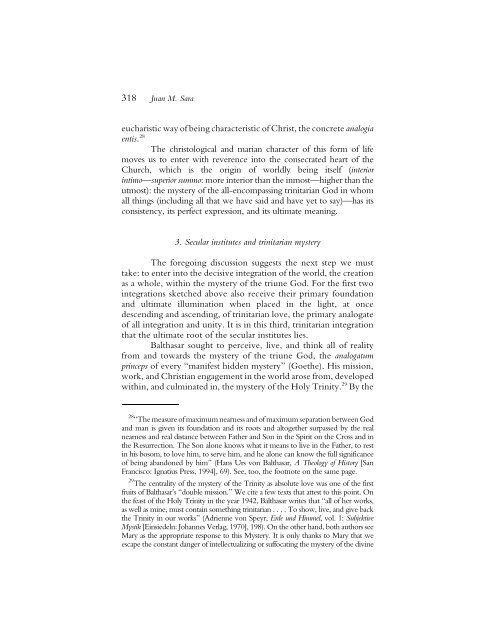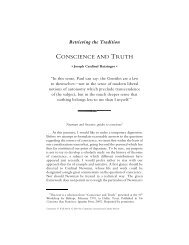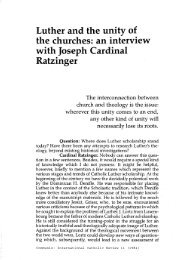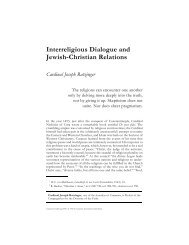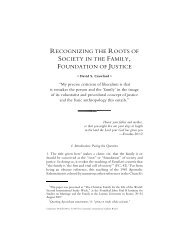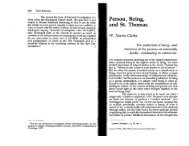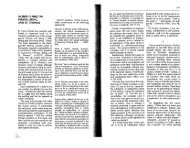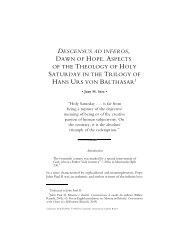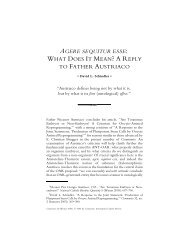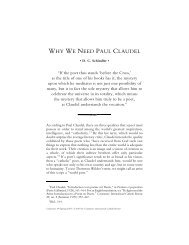Juan Sara. Secular Institutes According to Hans Urs ... - Communio
Juan Sara. Secular Institutes According to Hans Urs ... - Communio
Juan Sara. Secular Institutes According to Hans Urs ... - Communio
Create successful ePaper yourself
Turn your PDF publications into a flip-book with our unique Google optimized e-Paper software.
318 <strong>Juan</strong> M. <strong>Sara</strong><br />
eucharistic way of being characteristic of Christ, the concrete analogia<br />
entis. 28<br />
The chris<strong>to</strong>logical and marian character of this form of life<br />
moves us <strong>to</strong> enter with reverence in<strong>to</strong> the consecrated heart of the<br />
Church, which is the origin of worldly being itself (interior<br />
intimo—superior summo: more interior than the inmost—higher than the<br />
utmost): the mystery of the all-encompassing trinitarian God in whom<br />
all things (including all that we have said and have yet <strong>to</strong> say)—has its<br />
consistency, its perfect expression, and its ultimate meaning.<br />
3. <strong>Secular</strong> institutes and trinitarian mystery<br />
The foregoing discussion suggests the next step we must<br />
take: <strong>to</strong> enter in<strong>to</strong> the decisive integration of the world, the creation<br />
as a whole, within the mystery of the triune God. For the first two<br />
integrations sketched above also receive their primary foundation<br />
and ultimate illumination when placed in the light, at once<br />
descending and ascending, of trinitarian love, the primary analogate<br />
of all integration and unity. It is in this third, trinitarian integration<br />
that the ultimate root of the secular institutes lies.<br />
Balthasar sought <strong>to</strong> perceive, live, and think all of reality<br />
from and <strong>to</strong>wards the mystery of the triune God, the analogatum<br />
princeps of every “manifest hidden mystery” (Goethe). His mission,<br />
work, and Christian engagement in the world arose from, developed<br />
within, and culminated in, the mystery of the Holy Trinity. 29 By the<br />
28 “The measure of maximum nearness and of maximum separation between God<br />
and man is given its foundation and its roots and al<strong>to</strong>gether surpassed by the real<br />
nearness and real distance between Father and Son in the Spirit on the Cross and in<br />
the Resurrection. The Son alone knows what it means <strong>to</strong> live in the Father, <strong>to</strong> rest<br />
in his bosom, <strong>to</strong> love him, <strong>to</strong> serve him, and he alone can know the full significance<br />
of being abandoned by him” (<strong>Hans</strong> <strong>Urs</strong> von Balthasar, A Theology of His<strong>to</strong>ry [San<br />
Francisco: Ignatius Press, 1994], 69). See, <strong>to</strong>o, the footnote on the same page.<br />
29 The centrality of the mystery of the Trinity as absolute love was one of the first<br />
fruits of Balthasar’s “double mission.” We cite a few texts that attest <strong>to</strong> this point. On<br />
the feast of the Holy Trinity in the year 1942, Balthasar writes that “all of her works,<br />
as well as mine, must contain something trinitarian . . . . To show, live, and give back<br />
the Trinity in our works” (Adrienne von Speyr, Erde und Himmel, vol. 1: Subjektive<br />
Mystik [Einsiedeln: Johannes Verlag, 1970], 198). On the other hand, both authors see<br />
Mary as the appropriate response <strong>to</strong> this Mystery. It is only thanks <strong>to</strong> Mary that we<br />
escape the constant danger of intellectualizing or suffocating the mystery of the divine


